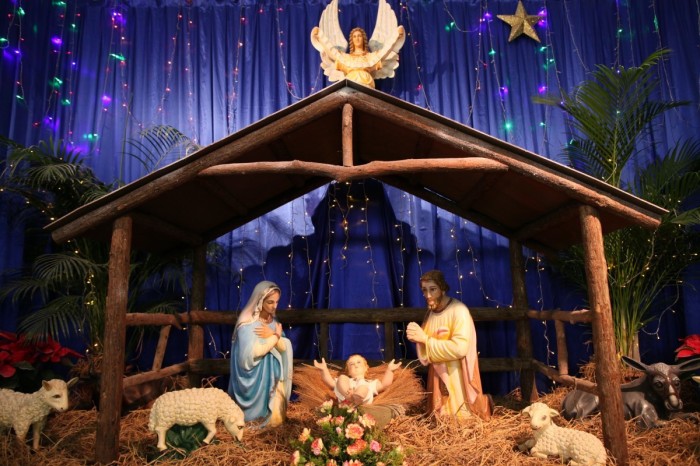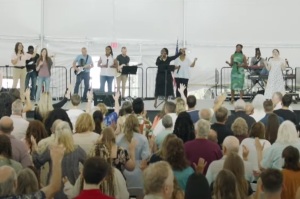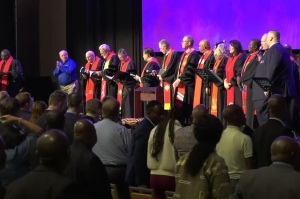The little-known history of the Nativity play

In the run-up to Christmas, primary schools and Sunday schools often put on Nativity plays. This custom, however, is a surprisingly modern tradition. Here is its story.
Nativity plays
A Nativity play is a production that tells the story of the events surrounding the birth of Jesus. These plays are typically performed shortly before Christmas, either by primary schools in assembly halls or by Sunday schools in local churches or chapels.
The word Nativity entered English via Norman French from the Latin nativitas, meaning birth. The root of this word also gives us native. In English, Nativity can simply mean birth, but it is usually used in the context of the birth of Jesus.
Mystery plays
In medieval England, religious mystery plays brought Bible stories to life for the largely illiterate population. During a time when few could read and even fewer had access to a Bible (which was usually in Latin), dramatic enactments of these stories became an effective means of teaching. Initially, monks performed these plays in Latin as a form of evangelism, which limited their accessibility.
In 1210, Pope Innocent III expressed concerns about the popularity of mystery plays and decreed that clergy could no longer take part in or write them. This effectively banned the plays in their original form. As a result, local town guilds took over and secularized the plays. Freed from clerical control, they began writing the scripts in English, which increased their popularity.
When mystery plays were performed around Christmas, they often told the story of Jesus' birth and the surrounding events.
The first Nativity play
The first Nativity play is often attributed to St Francis of Assisi, who staged one in Greccio, Italy, in 1223. According to tradition, St Francis invited the locals to a nearby cave, where he delivered a Christmas sermon in front of a manger, complete with a real baby, a donkey, and an ox. This portrayal of the Nativity proved so popular that it became an annual tradition, spreading throughout Europe via Franciscan monks.
However, after the Reformation, theatrical performances that took liberties with biblical texts were discouraged in Protestant Europe. In England, Puritans went so far as to ban Christmas and Nativity plays, classifying them as sacrilegious. These plays survived only in Catholic countries. Consequently, despite their historical roots, the re-emergence of Nativity plays in Britain is a surprisingly modern phenomenon.
The London revival
The popularization of Nativity plays in Britain is largely credited to Laurence Housman (1865–1959). Housman wrote "Bethlehem," a Nativity play adapted from a 14th century Coventry mystery play. Set to music by Joseph Moorat and interspersed with Christmas carols, it was first performed at the University of London on Dec. 17, 1902, for five nights. The play was later published as "Bethlehem: A Nativity Play" by Macmillan, enabling others to stage their own productions using the script.
Housman's play gained widespread attention in the 1920s. From December 1923, "Bethlehem" was performed at the Regent Theatre in King's Cross, London, running for six weeks. It then toured the country in 1924, inspiring local productions and leading to a national revival of Nativity plays. The Liverpool Daily Post noted in 1924: "Never since the Reformation, when things were repressed by stern measures, has there been such revival of the Nativity plays which formed so important a part the life of mediaeval England."
The Nativity play on the BBC
The first Nativity play to be broadcast on radio was aired on Dec. 22, 1926. This play, also titled Bethlehem, was adapted for radio by the Rev. Bernard Walke, vicar of St. Hilary's Church in Cornwall. Performed by members of his congregation in their Cornish accents, the play was broadcast live from St Hilary's Church. The broadcast received thousands of supportive letters and became a beloved annual tradition on the BBC's Christmas radio schedule until 1936.
The modern revival
Thanks to the influence of Housman's play and the popularity of the Nativity broadcasts, Nativity plays began to be performed more widely. By 1932, the Bucks Examiner observed: "A striking feature of the religious observance of Christmas this year is the number of Nativity plays being produced in so many churches across the country."
During World War II, evacuee children often swelled the cast of village Nativity plays. By the 1950s, Nativity plays had become a standard part of school and church life across Britain and all Christian denominations.
Nostalgia
For many children, participating in a Nativity play marks their first experience on stage. These plays are cherished for their charm, humor and occasional mishaps — whether from forgotten lines or ad-libbed surprises. Many adults fondly remember their own roles, such as a misguided innkeeper offering a room or a wise man bringing "Gold, Frankenstein and myrrh."
The biblical story
Nativity plays take creative liberties to condense the biblical story. The accounts of Jesus' birth are found in the first two chapters of Matthew and Luke. Both Gospels describe Mary's betrothal to Joseph (Matthew 1:18, Luke 1:27), the divine conception by the Holy Spirit (Matthew 1:18, Luke 1:35), and the angelic announcement of the name Jesus (Matthew 1:21, Luke 2:21). Both also agree that Jesus was born in Bethlehem during King Herod's reign (Matthew 2:1, Luke 2:4-7).
Luke details the angel's announcement to Mary (Luke 1:26-56), the census, the journey to Bethlehem, and the shepherds' visit (Luke 2:1-20). Matthew, on the other hand, recounts the visit of the Magi, or wise men, guided by a star (Matthew 2:1-12).
Artistic license
Artistic license often includes animals in the Nativity scene, despite the Bible only mentioning a manger. Similarly, while the Bible does not specify the number of wise men, tradition assigns three, corresponding to their gifts of gold, frankincense and myrrh. Nativity plays typically compress the timeline, placing the Magi at the stable alongside the shepherds, although the biblical account implies they arrived much later.
Modern Nativity plays
Today, Nativity plays are a cherished tradition in British primary schools and Sunday schools. Children dress as angels, shepherds, wise men, and key figures like Mary, Joseph, and King Herod. Sometimes they also portray animals, such as the donkey or stable creatures.
Plays may be narrated with mimed roles or feature spoken lines. Smaller groups might include adults to fill roles or have children take on multiple parts. The baby Jesus is often represented by a doll. Audiences typically consist of parents, grandparents and teachers, or in the case of church performances, congregations bolstered by friends and family.
Nativity plays have become an integral part of British culture, offering a way for even those who do not regularly attend church to engage with the biblical story.
This article was originally published at Christian Today





























